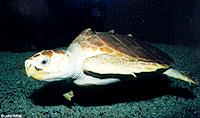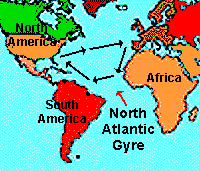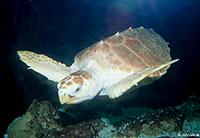|
October 25, 2001
 We use light, sound, pressure, temperature, smell and taste to explore the
outside world. However, our senses are tuned to only a small portion of
the signals in the environment. For instance, the light we can see is
only a small part of the electromagnetic
spectrum. Other animals make use of signals in the environment that
we cannot detect without special instruments. For example, rattlesnakes
can "see" infrared wavelengths with pit organs and butterflies can see
ultraviolet light. Moreover, we hear only sounds that have frequencies
between 20 and 20,000 Hz. Elephants can hear sounds with frequencies
below 20 Hz while bats, dolphins and dogs can hear sounds with frequencies
above 20,000 Hz. New research shows that sea turtles take advantage of
another environmental signal that humans cannot detect: magnetic
fields!
We use light, sound, pressure, temperature, smell and taste to explore the
outside world. However, our senses are tuned to only a small portion of
the signals in the environment. For instance, the light we can see is
only a small part of the electromagnetic
spectrum. Other animals make use of signals in the environment that
we cannot detect without special instruments. For example, rattlesnakes
can "see" infrared wavelengths with pit organs and butterflies can see
ultraviolet light. Moreover, we hear only sounds that have frequencies
between 20 and 20,000 Hz. Elephants can hear sounds with frequencies
below 20 Hz while bats, dolphins and dogs can hear sounds with frequencies
above 20,000 Hz. New research shows that sea turtles take advantage of
another environmental signal that humans cannot detect: magnetic
fields!
 Baby
loggerhead sea turtles (Caretta caretta) swim from the southeast
coast of the United States into the North Atlantic Ocean where they find a
warm water current called the North Atlantic gyre. The turtles follow
this current for five to ten years before returning to the coast where
they were born. However, if they stray away from the warm gyre, cold
water will kill them. How do the turtles know where to go? How do they
avoid the cold water? Scientists in the Department of Biology at the
University of North Carolina, now think they know how the turtles navigate
across the Atlantic Ocean and stay within the warm current. Baby
loggerhead sea turtles (Caretta caretta) swim from the southeast
coast of the United States into the North Atlantic Ocean where they find a
warm water current called the North Atlantic gyre. The turtles follow
this current for five to ten years before returning to the coast where
they were born. However, if they stray away from the warm gyre, cold
water will kill them. How do the turtles know where to go? How do they
avoid the cold water? Scientists in the Department of Biology at the
University of North Carolina, now think they know how the turtles navigate
across the Atlantic Ocean and stay within the warm current.
The scientists knew that magnetic fields vary across the earth's surface.
To test whether loggerhead turtles could use information about magnetic
fields, the scientists placed turtle hatchlings into a pool of sea water
which was surrounded by electric coils. The coil system could be adjusted
to change the magnetic fields around the pool. The location of each
turtle was monitored by a computer tracking system.
| The direction that the turtles swam was
dependent on the magnetic field. |
| Type of Magnetic Field |
Swimming Direction |
 |
| Northern Florida Coast | East-Southeast |
Coast of Portugal | South |
Coast north of
Brazil | West-Northwest |
The path the turtles swam was influenced by the different magnetic fields
that the scientists provided. The directions in which the turtles swam
would have kept them within the warm North Atlantic gyre. Thus, it is
likely that baby sea turtles have the innate ability to detect magnetic
fields and use these cues for navigation. The brain mechanisms involved in
the detection of magnetic fields remain a mystery for future study.
|


![[email]](./gif/menue.gif)



